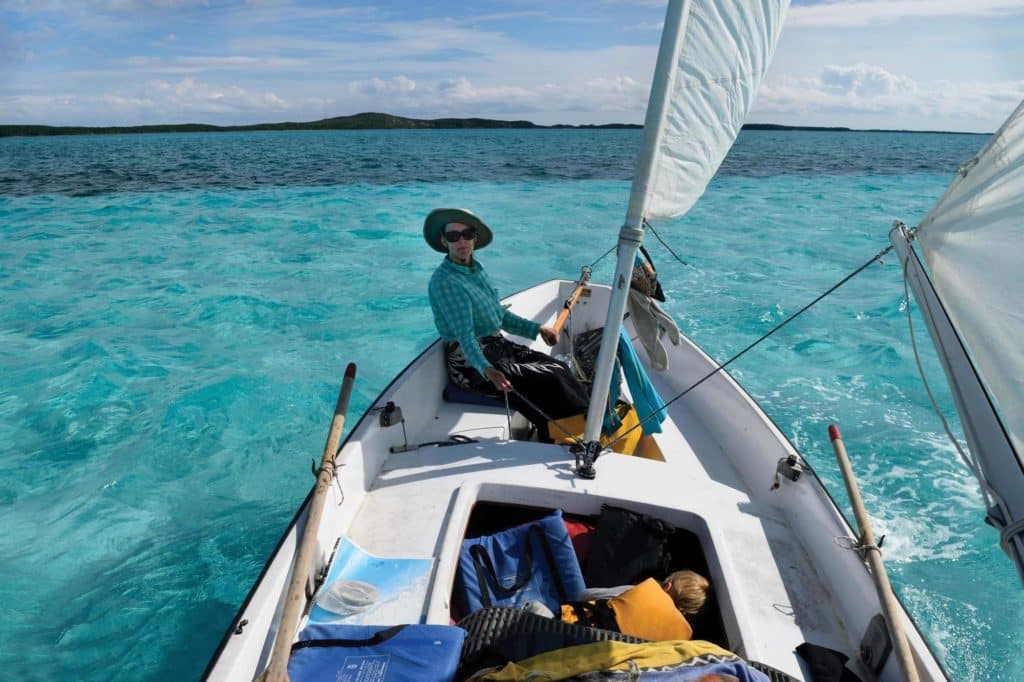
Water splashed over the bow as I held the Sea Pearl 21 tight to the wind. Glancing to port, I gauged the distance between our little boat and the nearby coral-laced cut between two deserted Bahamian cays. The tide was ebbing fast into the open ocean beyond, which meant we were fighting the current as well as the wind.
I guessed we were making 2 knots. Maybe. But I was grinning, exhilarated to finally be sailing across the bright blue waters I’d dreamed about for so long.
“We’re gonna round the point on this tack, Bri, I can feel it!” my husband, Rob, called. He was manning the clunky wooden oars from a makeshift seat on our cooler in the center of the boat. Rowing gave us a helpful boost since we had no motor aboard.
At Rob’s feet, our 3-year-old son, Talon, was napping in a yellow life jacket, using a dry bag as a pillow. I reached over to adjust our toddler’s hat to block the late-afternoon sun, then pulled in the mizzen another inch. And that’s when the 30-knot gust hit.
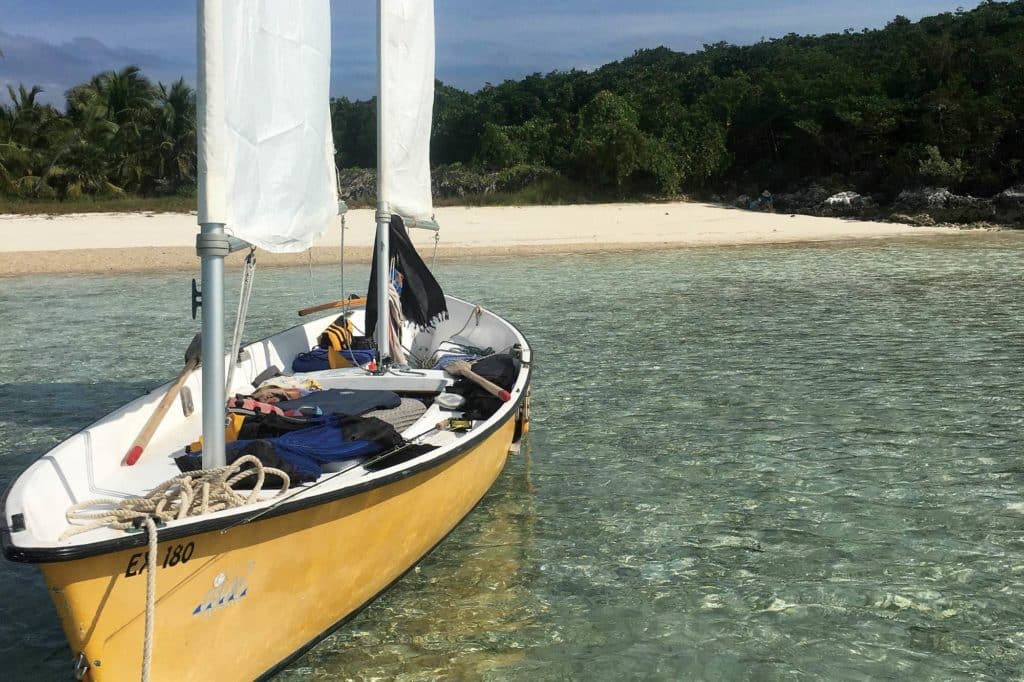
We were halfway through a weeklong bareboat cruise in the Exumas, a playground for anyone who loves white-sand beaches, clear-water snorkeling and cruising between deserted islands.
And when I say “bareboat,” I mean bare bones, as well as captainless. We chose to charter the Sea Pearl from Out Island Explorers for two reasons: first, affordability. At $1,000 for eight days, the price was one-fifth the cost of chartering a larger sailboat.
Second, accessibility. Hundreds of miles of shallow waters and shifting sands make the Exumas one of the most beautiful places on Earth—and one of the more challenging places to navigate without grounding. Sea Pearls draw only 8 inches with the daggerboards up, and their flat bottom allows them to be beached. Most monohulls can’t sail on the Bahama Banks side of the southern portion of the Exumas island chain, which means battling the rougher conditions on Exuma Sound and missing some of the most stunning anchorages in the area. Even shoal-draft catamarans risk grounding in many of the Exumas’ pocket bays, which drain completely at low tide.
The downside of chartering the Sea Pearl? It’s basically a big canoe. Without a cabin, we had to camp ashore every night.
Five days before, we’d done our food provisioning at the only grocery store in George Town, the main settlement on Great Exuma. The next morning, Dallas Knowles, owner of Out Island Explorers, picked us up, and we drove north to Barraterre Cay. The charter price included enough fresh water for our week at sea, packed in dromedary bags. We also rented a stove and fuel from Knowles at a nominal price, along with a couple of beach chairs and a small folding table—camping gear that was too bulky (or illegal) for airplane luggage.
At a small dock with no other boats in sight, Knowles showed us how to rig and sail the Sea Pearl. The sails slide on sleeves down two identical masts, one forward and the other aft, and are reefed by simply twisting the mast in its step. Sails are unfurled by pulling on the outhaul line along the boom. Two lead-weighted leeboards swing off the gunwales on either side, easily raised in shallow water by pulling a line and securing it in cam cleats on the rails. Without a keel, these boats don’t point particularly well and perform best downwind.
Knowles gave us charts and detailed descriptions of various anchorages and potential routes for our eight-day cruise. He also handed us a small repair kit and an old-school push-button cellphone to call him if we needed help or wanted a weather report. Then he threw us the dock lines, calling out: “Have fun! Be safe!” Talon waved goodbye as we sailed east toward Boysie Cay.
The first three nights we’d found private, pristine beaches where we could nose the Sea Pearl right up to shore. Winds had been light, but I hadn’t minded the lack of a motor. Calm conditions were great for snorkeling and fly-fishing from the boat, and the oars worked well for maneuvering the 700-pound Sea Pearl when becalmed.
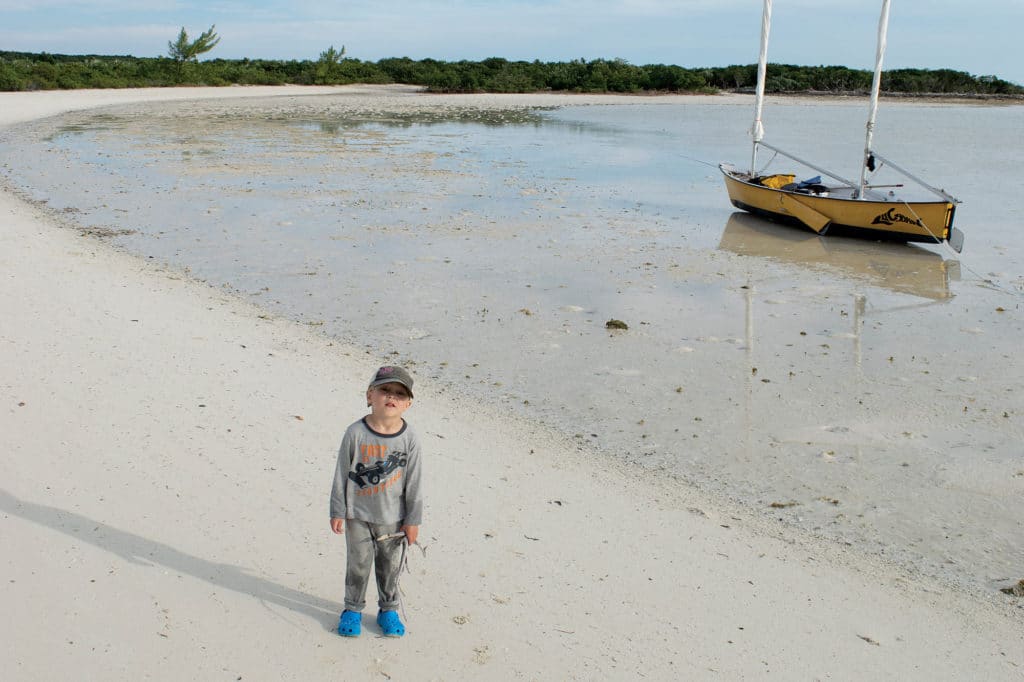
Day four had started out perfect for sailing. After a breakfast of eggs and bacon, we packed up camp on Normans Pond Cay, then sailed to the island’s northern shore in a lovely 15-knot breeze. Anchoring in a calm bay, we ate lunch on a deserted beach. Rob and I took turns exploring the reef while the other played tag in the sand with our son.
When it was my turn to snorkel, I dived down to spy on two big lobsters hiding under purple fan coral. The water in the Exumas was as clear as a looking glass, and rife with cool sea life. So far, we’d snorkeled alongside schools of snappers and jacks, stingrays, turtles, moray eels, and a reef shark.
Around 3 p.m., we reboarded the boat for the short 3-mile sail to Williams Cay, where we planned to camp that night in a well-protected bay. A norther was predicted to blow in around sunset. Since we could see whitecaps forming, we reefed both sails and donned foul-weather gear.
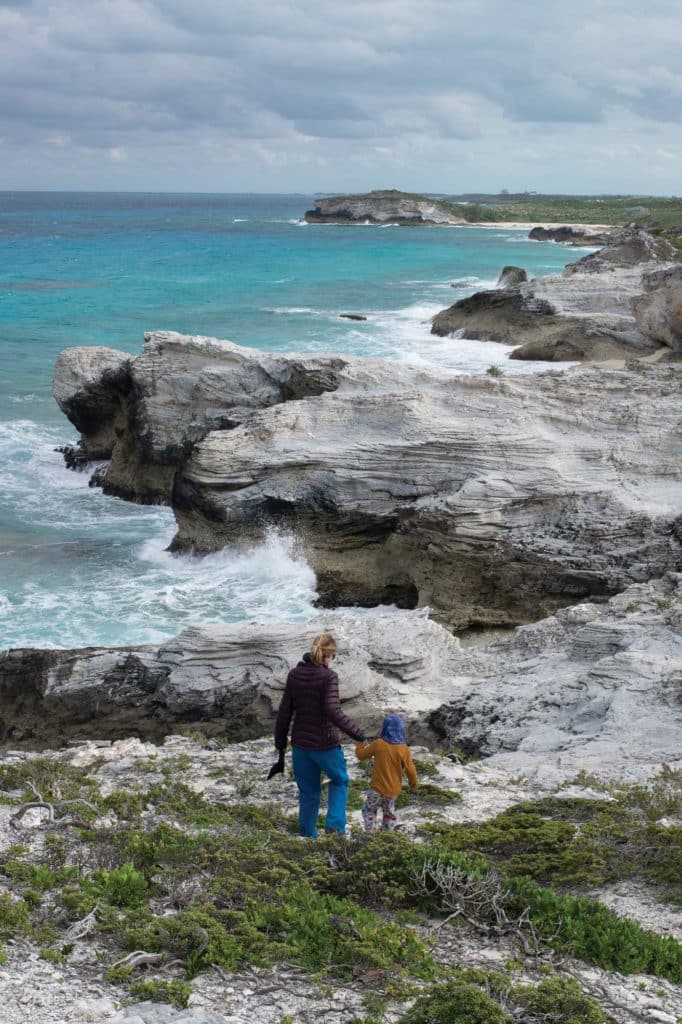
It had been fun sailing for the first half-hour, but then the wind began to howl from the direction we were trying to sail, and a current was steadily pushing us sideways. I was starting to wish for some iron horsepower, especially as a 30-knot gust hit us, just 300 yards from the point we were trying to round.
Rip! The mizzen tore above me, the wind rendering the sail to tatters. I lost steerage and couldn’t keep the boat pointed to windward with just the reefed main. Rob began rowing harder to give us more speed.
Crack! The starboard oar snapped in half. We exchanged a look of disbelief. The tide carried the Sea Pearl quickly toward the cut and the open water beyond.
We had to think fast so we didn’t end up on a reef. I turned the boat downwind toward a speck of white sand—the last holdout between us and the open ocean. Fifty yards from shore, Rob let out the mainsheet to slow us down, then hopped overboard to hold the boat off the rocks bracketing the beach.
I chucked the stern anchor over, then hopped in too, stubbing my bare toes on a piece of coral. The water was chest-deep. Waves buffeted the boat, turning it into a bucking battering ram as we struggled to secure it.
At the bow, Rob was trying to dive down to bury the main anchor in the sand, frustrated because he kept floating to the surface.
“You still have your life jacket on!” I yelled. He pulled it off, then set the anchor to keep the bow pointed into the wind and waves.
As Rob climbed back aboard to roll up the flogging sails and unrig the boat, I reached into the center hold, pulling up our son by his arms and hoisting him over my shoulder. Wading to shore, a part of me floating above the scene marveled at my adrenaline-fueled strength.
I put Talon gently on the sand in the shade of a large boulder. Miraculously, he stayed asleep. Rob started wading to shore, holding our day bag overhead—a backpack full of snacks, water, extra clothes, navigation charts and the emergency cellphone.
Closing my eyes, I took a deep breath, relieved that we were all safe. I took stock of our surroundings as I shed my sodden life jacket, foul-weather gear and clothes. An abandoned house stood above the small beach, its paint long peeled off. The sun, framed by billowing gray clouds, was only a couple of hands above the horizon. I could smell rain in the air. Waves rumbled like thunder on the outside reef.
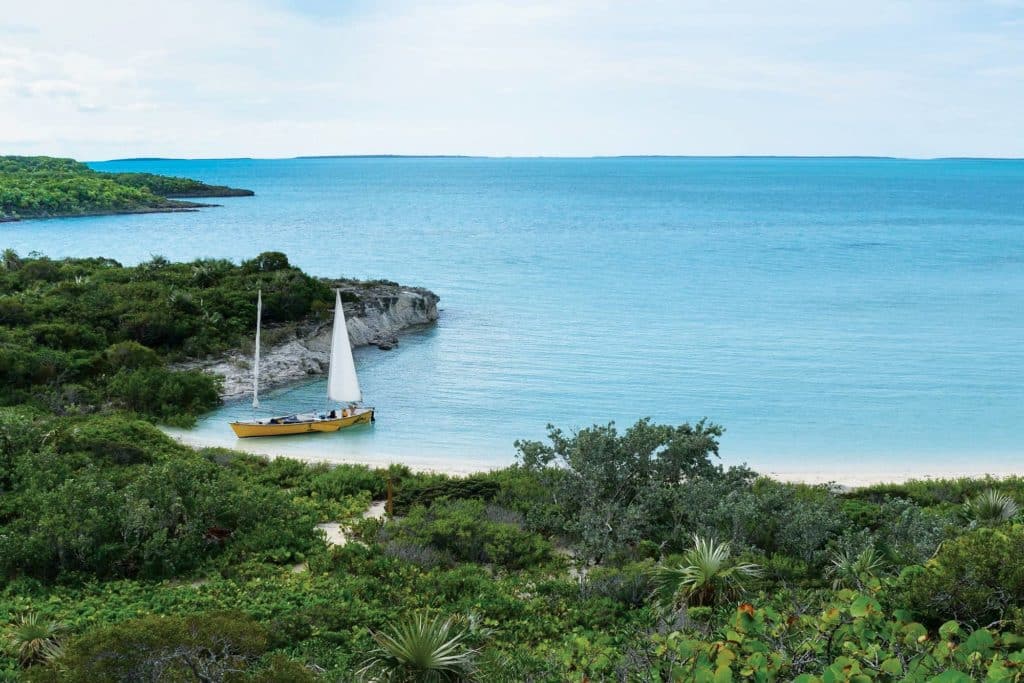
With the boat secure and all of us safe, I called Knowles to explain the situation. He came to the rescue two hours later in a twin-engine fishing boat, a new mizzen sail rolled up along the gunwale. Working fast in the fading evening light, we rigged a tow line on the Sea Pearl so Knowles could tow it to Twin Beach, the anchorage we’d originally been aiming for.
Talon—who’d taken our near-emergency in stride upon waking in the sand instead of in the cockpit—was thrilled about riding in a shiny, fast powerboat. He laughed as we sped across the choppy silver water.
“You handled yourselves well,” Knowles said. “That definitely could have been bad news.”
He never asked if we wanted to call it quits after the traumatic afternoon. Maybe he knew we’d say no.
As he helped us untie and anchor the Sea Pearl, Knowles told us the wind was supposed to get stronger that night, then clock around to the southeast. Rob asked whether we should take advantage of the wind shift to sail over to the rarely visited Brigantine cays for the last half of our trip.
“If you check out the Brigantines, you could tack up the Odi Creek to Barraterre and make a full loop,” Knowles suggested. “Just call me that morning and let me know if you want me to pick you up at the dock or at Odi Creek.”
After he zoomed off, we set up camp in record time. The rain began after we climbed into the tent, where we ate a cozy picnic dinner and read each other stories, grateful to be together and sheltered.
The next morning, we woke to clear skies, though the wind was still whipping up chop beyond our little bay. We took a rest day to regroup. While Rob stayed at camp, Talon and I went for a hike.
We climbed up a rocky ridge, spotting dozens of giant stingrays swimming in the shallows below us, their black bodies rippling like the skirts on a flamenco dancer. Then we headed to the other side of the island to treasure hunt, finding a washed-up soccer ball, a doll and a wooden sword. Back at camp, Talon created castles from pearly-pink conch shells—the ubiquitous (and tasty) Bahamian mollusk. That evening we collected firewood and made a bonfire, watching the moon rise and the Milky Way appear.
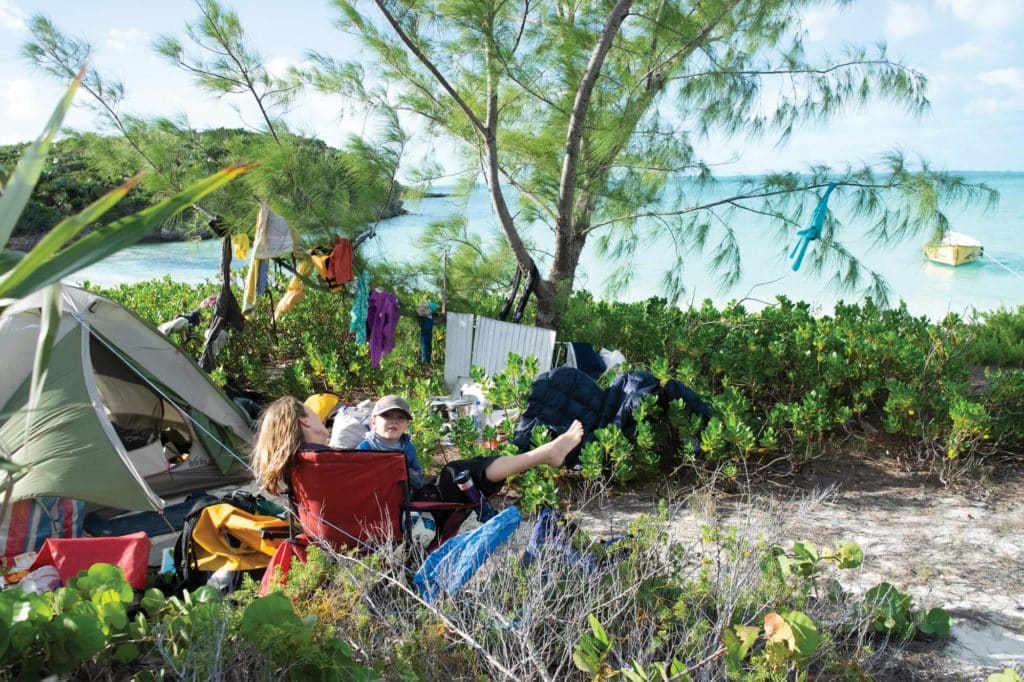
Rejuvenated, we set out early the following day for the Brigantines, taking our time to explore along the way. Talon and Rob fished from the boat for snapper at Tug and Barge rocks, while I snorkeled alongside two curious barracudas.
Though only 5 miles from the windward cays in the Exumas, the Brigantines felt very different—and even more remote. The water was a beautiful milky green due to limestone deposits, and the beaches were larger. Acres of silty-soft sand were exposed at low tide, where a maze of protruding mangrove roots arched over mounds made by clams. The Sea Pearl was perfect for gunkholing in these shallow waters. We saw only two other boats in two days, both manned by local fishermen.
We stopped to camp at a mile-long crescent of beach on Brigantine Cay. Talon helped collect coconuts to drink with our dinner of chicken and rice, proud of his tropical foraging skills. At sunset we set up hermit crab races, betting on whose temporary pet would make the finish line before getting distracted.
On our final day in the Exumas, the weather turned again. We stuck close to the mangroves to skirt the wind and waves as we headed back to Barraterre Cay. The last mile was almost comical—we had to tack at least four dozen times to sail up narrow Odi Creek. Luckily, we made it just before the rain started pouring down.
After hoisting ourselves into Knowles’ truck, I reached over to give him a high-five.
“No one I’ve chartered to has ever sailed all the way up Odi Creek,” Knowles admitted. “Most people choose the easier way back.”
“Yeah, we rarely choose the easy way,” I said with a laugh, winking at Rob. “But it usually leaves us with better stories to tell.”
Brianna Randall is a freelance writer and the founder of Adventure Families. She sails mountain lakes in Montana and cruises in the Bahamas any chance she gets.








